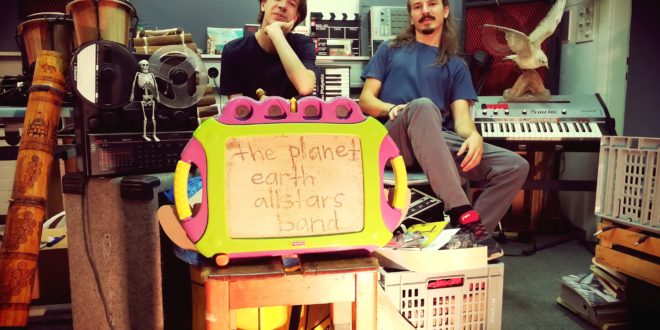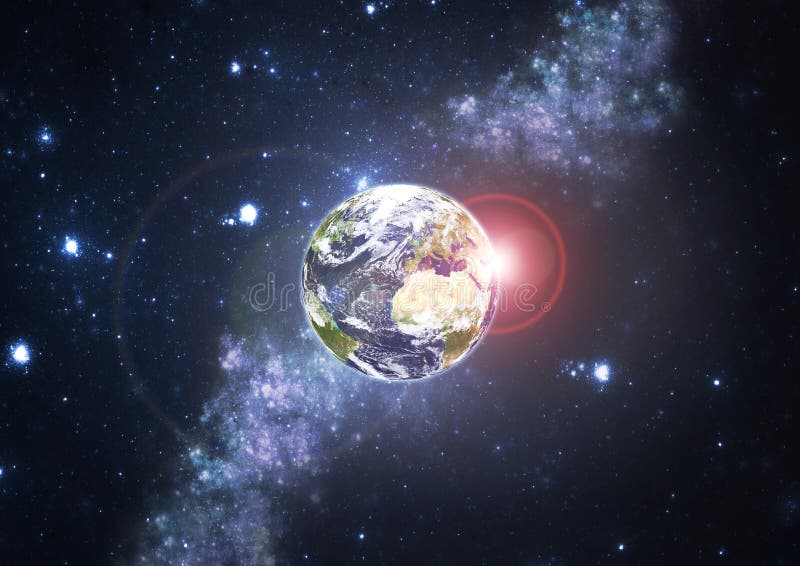Imagine gazing up at a clear night sky, a tapestry of twinkling lights scattered across the vast expanse. It’s a scene that has captivated humanity for generations, inspiring countless stories, myths, and scientific endeavors. The stars, those distant suns, hold within them the keys to understanding our own existence, the origins of the universe, and our place within this cosmic dance.

Image: www.keck-kiosk.ch
This article embarks on a journey to explore the fascinating connection between our planet, Earth, and the countless stars that adorn the celestial canvas. We’ll delve into the history of our understanding of the cosmos, explore the fundamental principles of stellar evolution, and uncover the intricate ways in which Earth and the stars are intertwined. This exploration will reveal how our planet is not merely a solitary island in space but an integral part of a grand, ever-evolving cosmic story.
Our Place in the Universe: A Story of Discovery
The journey to comprehending our place in the universe has been a long and winding one, marked by leaps of intellectual progress and technological advancements. For millennia, humans looked to the sky, attempting to decipher its mysteries. Ancient civilizations observed the predictable motions of the stars, charting their paths and utilizing them for navigation and timekeeping. Babylonian astronomers were among the first to catalog stars and constellations, laying the foundation for future celestial cartography.
The invention of the telescope in the 17th century revolutionized our understanding of the cosmos. Galileo Galilei’s observations revealed the phases of Venus, the moons of Jupiter, and the multitude of stars that compose the Milky Way, challenging the prevailing geocentric model of the universe. This paved the way for the heliocentric model, placing the Sun at the center of our solar system, a pivotal shift in human perception.
In the 20th century, our comprehension of the universe expanded exponentially. Albert Einstein’s theory of relativity redefined our understanding of gravity and the nature of space and time, while advancements in spectroscopy allowed us to analyze the composition of stars, revealing their chemical makeup and processes.
The Birth and Life Cycle of Stars
Stars, those celestial beacons, are born from vast clouds of gas and dust known as nebulae. These interstellar nurseries contain primarily hydrogen and helium, the building blocks of the universe. As gravity pulls these clouds together, they collapse under their own weight, causing the temperature and pressure within the core to rise dramatically.
When the core reaches a critical temperature and pressure, nuclear fusion ignites, transforming hydrogen into helium and releasing immense amounts of energy. This energy causes the star to shine brightly, creating the light and heat we see from Earth. This process, known as the main sequence stage of a star’s life, can last for billions of years, depending on the star’s mass.
As a star ages, its core gradually depletes its hydrogen fuel. For stars like our Sun, the outer layers expand and the star enters a red giant phase, becoming cooler and larger. Eventually, these stars shed their outer layers, forming planetary nebulae, and their cores collapse into dense white dwarfs. Larger stars, however, experience a more dramatic end.
Supernovae: The Explosive Birthplace of Elements
Massive stars, those with several times the mass of our Sun, meet their demise in cataclysmic explosions known as supernovae. These explosions are among the universe’s most powerful events, releasing an immense amount of energy and creating new elements in the process. The intense heat and pressure within the core of a massive star lead to the formation of heavier elements, such as carbon, oxygen, silicon, and iron.
When these stars collapse, the core rebounds violently, sending shock waves outward, blasting the star apart and dispersing its remnants into space. These remnants, enriched with newly formed elements, ultimately contribute to the formation of new stars and planets, including our own. This cyclical process of stellar death and rebirth is a fundamental aspect of cosmic evolution.

Image: www.animalia-life.club
Earth and the Stars: An Intertwined History
Our planet Earth, like all other objects in the solar system, is a product of cosmic events. The Sun, our own star, formed from a collapsing nebula, and the surrounding disk of gas and dust eventually coalesced into the planets, including Earth. The elements that make up our planet, the rocks, water, air, and even the very building blocks of life, were forged in the hearts of stars long ago.
The Sun’s constant outpouring of energy has been essential for life on Earth. Its gravity holds our planet in orbit, providing us with a stable climate, and its light and warmth provide the energy that powers life. The Sun is also the source of a constant stream of charged particles known as the solar wind. While this wind can disrupt our communications systems, it also plays a crucial role in safeguarding Earth from harmful radiation from deep space.
The Future of Earth and the Stars
As we look to the future, we are increasingly aware of the interconnectedness of Earth and the stars. Our planet is constantly being bathed in cosmic radiation, remnants of past supernovae and other celestial events. While some of this radiation is harmful, others are essential for life, such as ultraviolet radiation from the Sun, which is vital for photosynthesis.
Our understanding of the cosmos is constantly growing through advancements in telescopes, spacecraft, and other tools of exploration. With each new discovery, our perspective on our place in the universe shifts, revealing the vastness and intricate nature of the cosmos. The future holds an abundance of opportunities to explore this vastness, unraveling the mysteries that lie beyond our planet and furthering our understanding of the intricate dance between Earth and all the stars.
Earth And All The Stars
Conclusion: A Cosmic Journey of Discovery
The journey from ancient stargazers to modern astronomers has been one of awe and a constant quest for knowledge. As we gaze up at the night sky, we are not simply observing distant lights; we are witnessing the story of the universe unfolding before our eyes. Earth and all the stars are interconnected, bound together by a shared history and a common destiny. Our planet is a testament to the grand symphony of cosmic creation, a product of stellar evolution, and a participant in the grand cosmic dance. By continuing to explore the universe, we will uncover its secrets and deepen our understanding of not only the stars but also ourselves, our place in the universe, and the infinite wonders that await us in the vast expanse of space.






